Exploring Lifespan Development, Berk Chapter 1
1/92
There's no tags or description
Looks like no tags are added yet.
Name | Mastery | Learn | Test | Matching | Spaced |
|---|
No study sessions yet.
93 Terms
developmental science
a field of study devoted to understanding constancy and change throughout the lifespance

theory
an orderly, integrated set of statements that describes, explains, and predicts behavior
continuous
a process of gradually augmenting the same types of skills that were there to begin with
discontinuous
a process in which new ways of understanding and responding to the world emerge at specific times
stages
qualitative changes in thinking, feeling, and behaving that characterize periods of developments
contexts
unique combinations of personal and environmental circumstances that can result in different paths of change
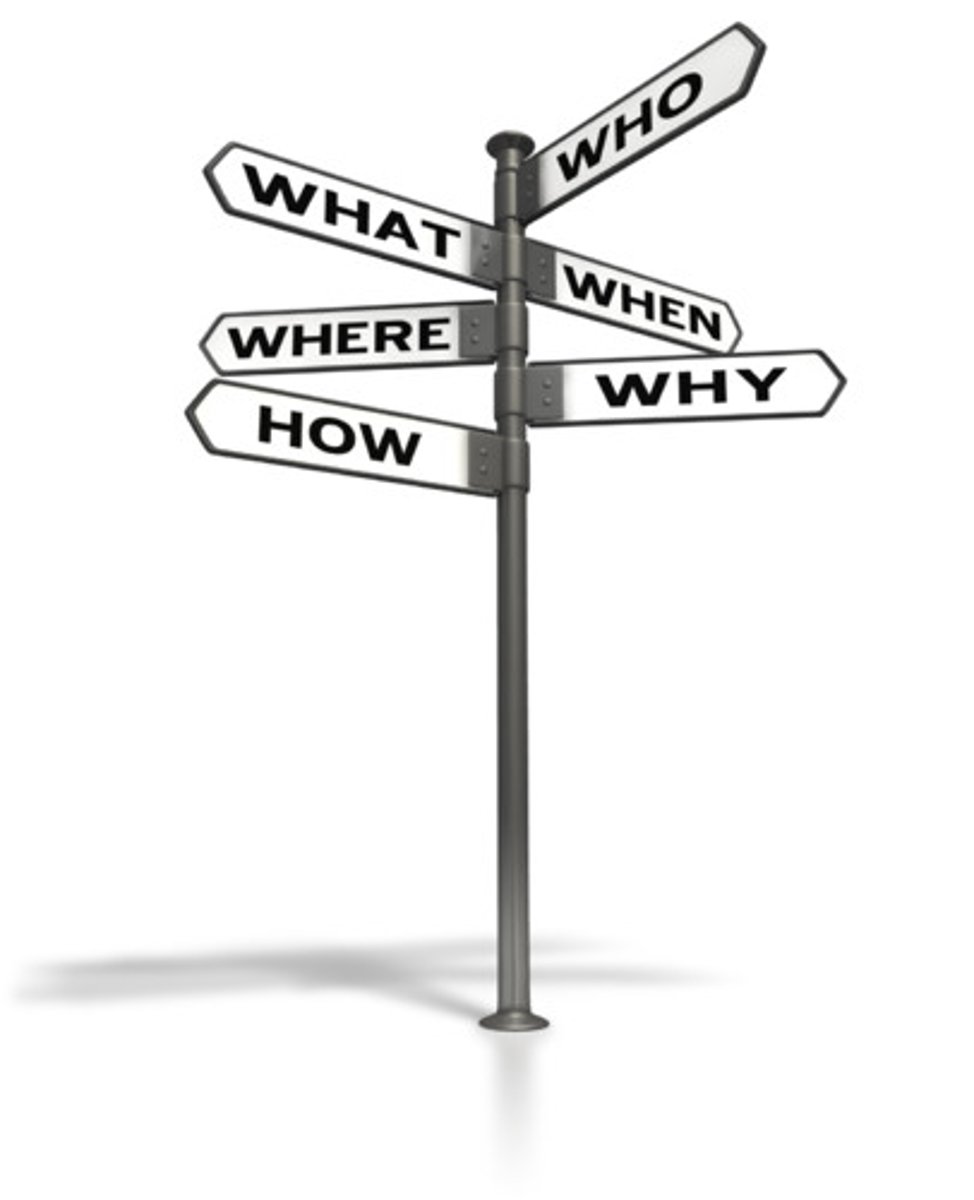
nature vs nurture controversy
the questions of whether genetic or environmental factors are more important to developments
nature
Hereditary info, from parents at conception
nurture
Physical and social forces
Influences bio and psychological development.
stability
Persistence of individual differences
Lifelong patterns established by early experiences
plasticity
Development is open to lifelong change
Change occurs based on response to influential experiences
lifespan perspective
four assumptions make up this broader view; that development is (1) lifelong, (2) multidimensional and multi-directional, (3) highly plastic, and (4) affected by multiple, interacting forces
Periods of Development
Prenatal Conception to birth
Infancy and toddler-hood Birth-2 years
Early childhood 2-6 years
Middle childhood 6-11 years
Adolescence 11-18 years
Early adulthood 18-40 years
Middle adulthood 40-65 years
Late adulthood 65 years-death
prenatal development period
conception to birth; the one-celled organism transforms into a human baby with remarkable capacities to adjust to life in the surrounding world.
infancy and toddlerhood period
birth to 2 years; dramatic changes in the body and brain support the emergence of a wide array of motor, perceptual, and intellectual capacities and first intimate ties to others.
early childhood
2-6 years; during the "play years," motor skills are refined, thought and language expand at an astounding pace, a sense of morality is evident, and children establish ties with peers.
middle childhood
6-11 years; the school years are marked by improved athletic abilities, more logical thought processes, mastery of fundamental reading, writing, math, and other academic knowledge and skills, advances in self-understanding, morality, and friendship, and the beginnings of peer-group membership.
adolescence
11-18 years; puberty leads to an adult-sized body and sexual maturity. Thought becomes abstract and idealistic and school achievement more serious. Adolescents begin to establish autonomy from the family and to define personal values and goals.
early adulthood
18-40 years; most young people leave home, complete their education, and begin full-time work. Major concerns are developing a career, forming an intimate partnership, marrying, rearing children, or pursuing other lifestyles.
survival of the fittest
Process by which individuals that are better suited to their environment survive and reproduce most successfully; also called natural selection. Darwin.
Influences on Development
Multiple, interacting forces:
Age-graded
History-graded
Non-normative
age-graded influences
events that are strongly related to age and therefore fairly predictable in when they occur and how long they last example
Is 16 get a drivers license
history-graded influences
explain why people born around the same time-called a cohort- tend to be alike in ways that set them apart from people born at other times. Grew up in depression then fix it don't throw it away.
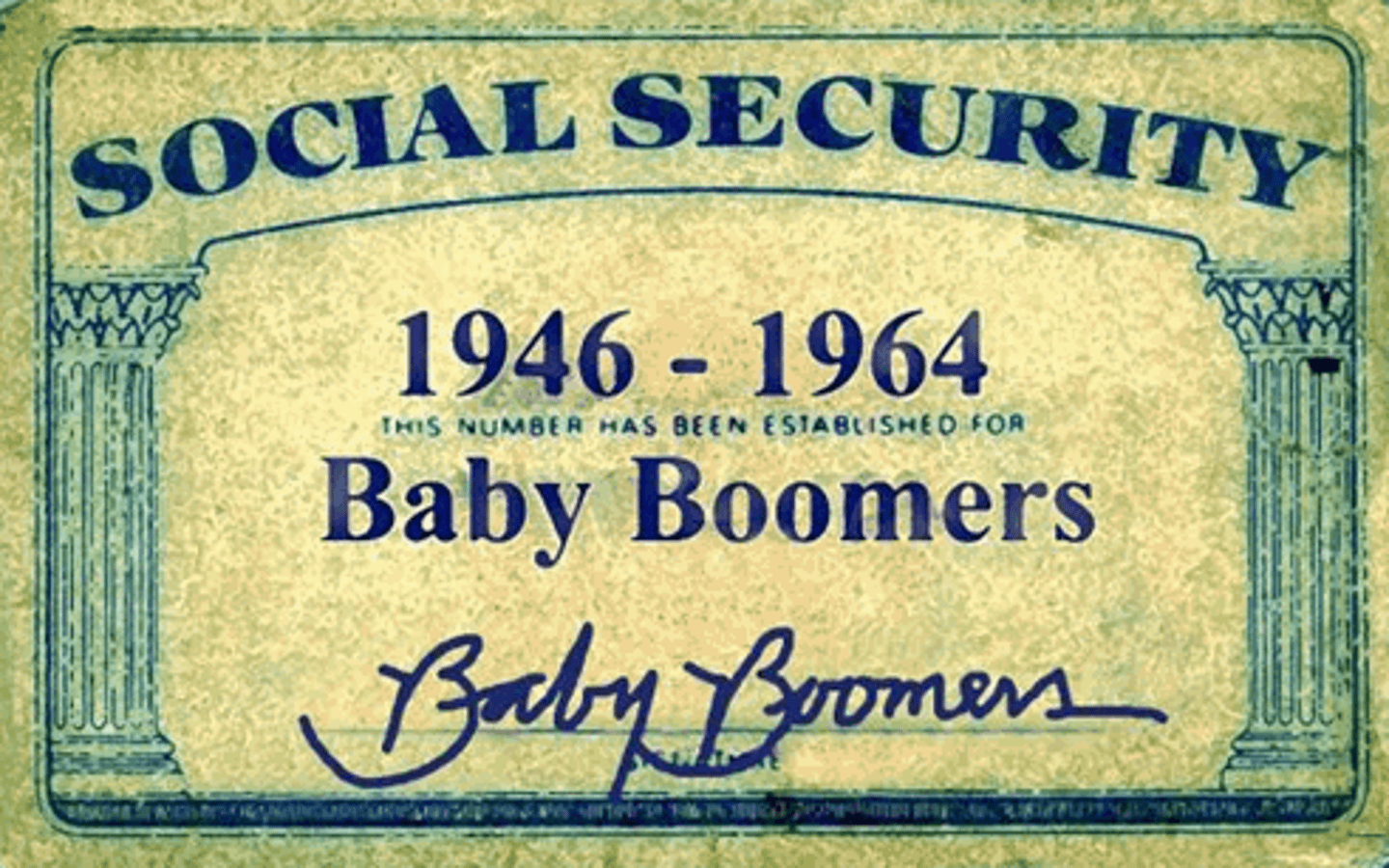
non normative influences
events that are irregular: they happen to just one person or a few people and do not follow a predictable timetable. Recession when everyone lost their homes and people went back to school

normative approach
measures of behavior are taken on large numbers of individuals, and age-related averages are computed to represent typical development
Hall, Gesell
Hall and Gesell created a system of measuring behavior in order to understand "average" or typical development as a function of age, allowing Gesell to write about the needs of children at certain ages and offer parenting advice
an attempt to solve intercultural problems
resilience
Ability to adapt effectively
in the face of threats to
development
Factors in resilience:
personal characteristics
- warm parental relationship
-social support outside family
- community resources and
opportunities

Applied Behavior Analysis (ABA)
Consists of careful observations of individual behavior and related environmental events, followed by systematic changes in those events based on procedures of conditioning and modeling. The goal is to eliminate undesirable behaviors and increase desirable responses.
normative approach
Hall, Gesell
- An approach to development in which measures of behaviour are taken on large numbers of individuals and age-related averages are computed to represent typical development
Scientific Beginnings
Darwin Theory of
evolution
Hall, Gesell Normative
approach
Binet Mental testing
movement
Early Scientific theory
Theory of evolution-Darwin
-Natural selection
-Survival of the fittest
Normative approach-Hall, Gesell
-Child study movement
-Development as a maturational process
Mental testing movement-Binet
-First successful intelligence test
-In forefront of nature-nurture controversy
psychoanalytic perspective
Freud and Erikson
people move through a series of stages in which they confront conflicts between biological drives and social expectations. How these conflicts are resolved determines the person's ability to learn, to get along with others, and to cope with anxiety
Freud's three parts of personality
Id
Largest portion of the mind
Unconscious, present at birth
Source of biological needs/desires
Ego
Conscious, rational part of personality
Emerges in early infancy
Redirects id impulses in acceptable ways
Superego
The conscience
Develops from ages 3 to 6 through
interactions with caregivers
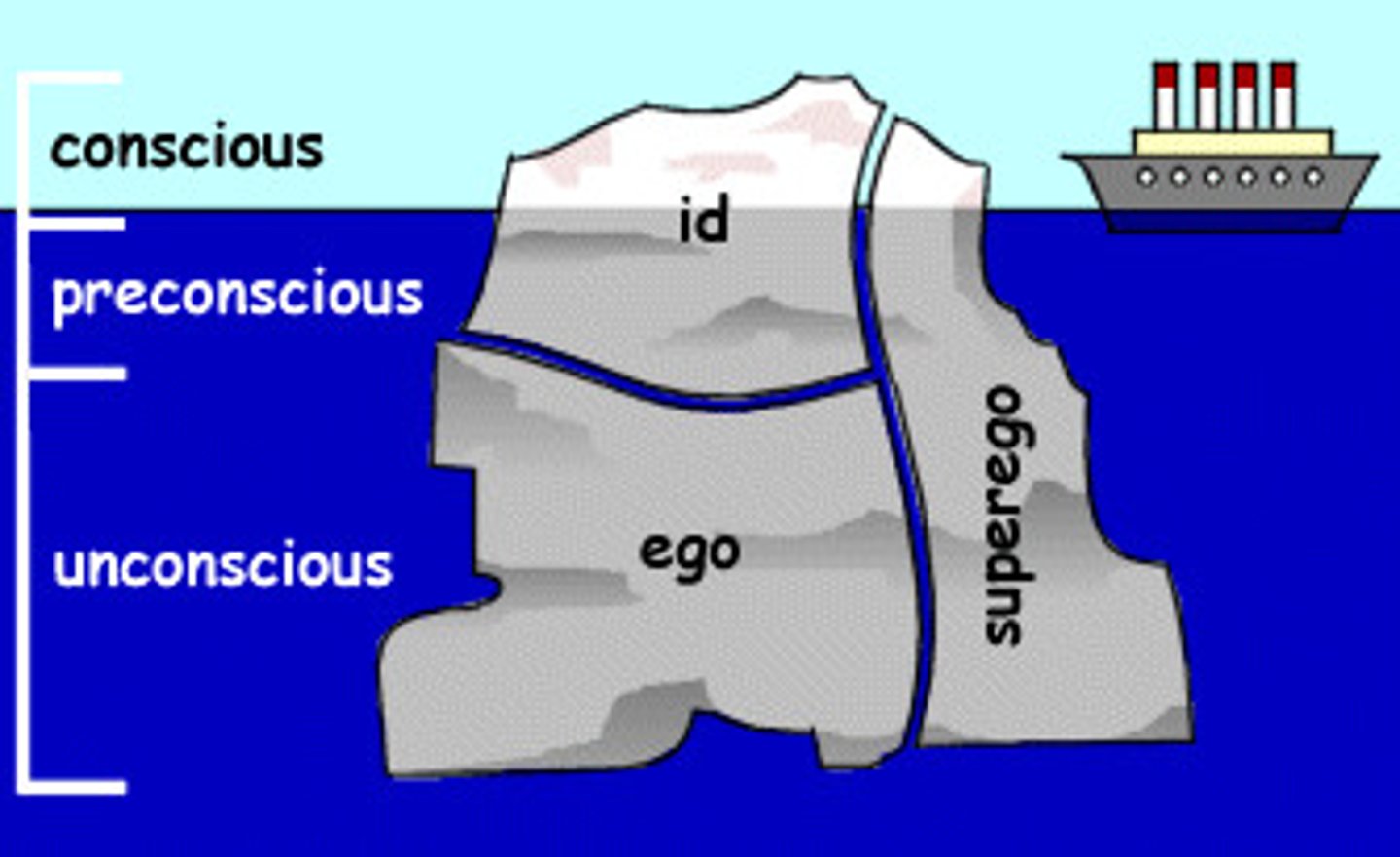
Id
Largest portion of the mind
Unconscious, present at birth
Source of biological needs/desires
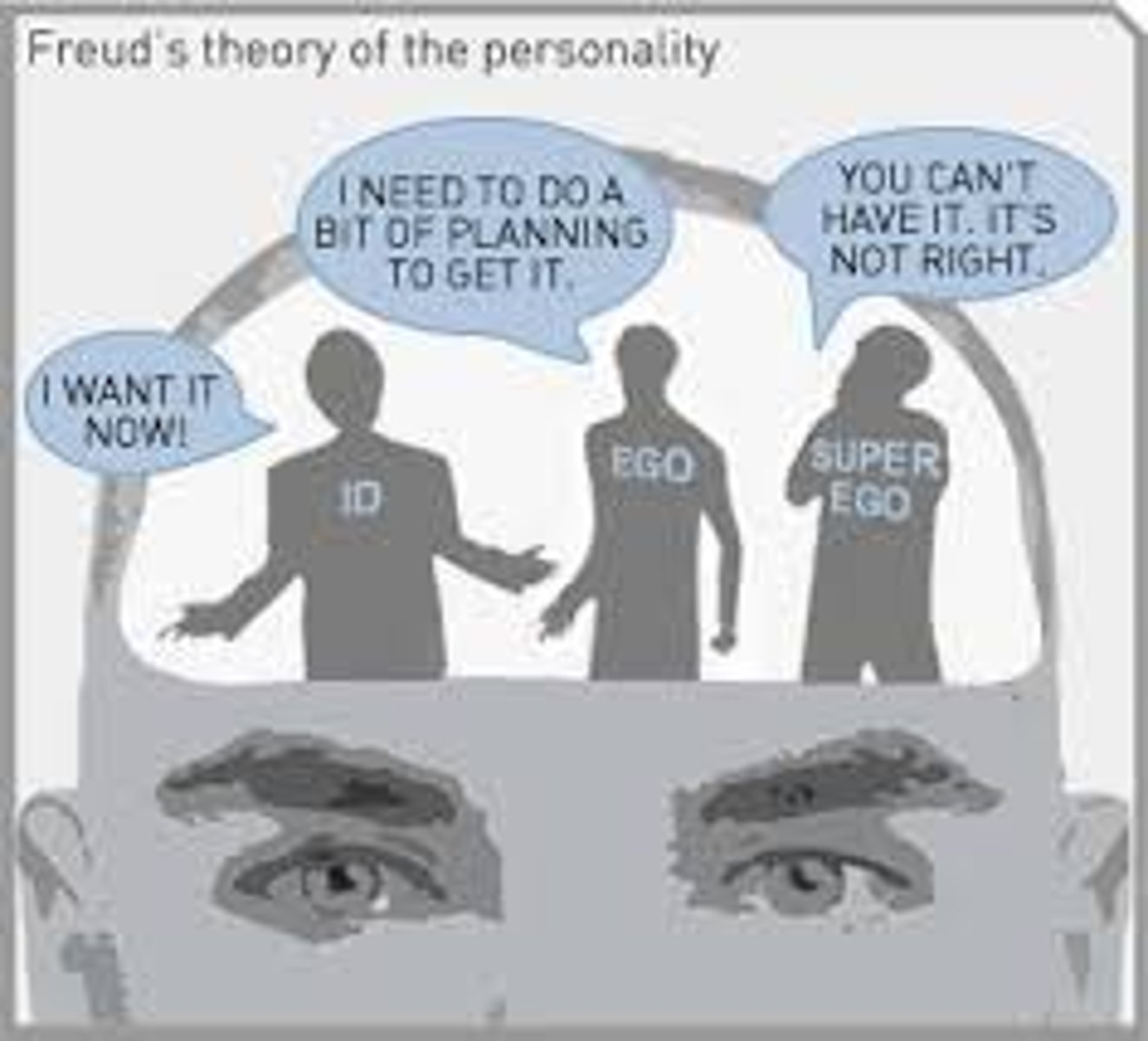
Ego
the largely conscious, "executive" part of personality that, according to Freud, mediates among the demands of the id, superego, and reality. The ego operates on the reality principle, satisfying the id's desires in ways that will realistically bring pleasure rather than pain.
Superego
the part of personality that, according to Freud, represents internalized ideals and provides standards for judgment (the conscience) and for future aspirations
psycho-sexual theory
emphasizes that how parents manage their child's sexual and aggressive drives in the first few years is crucial for healthy personality development
Oral
Anal
Phallic
Latency
Genital
Freud's Theory of Development:
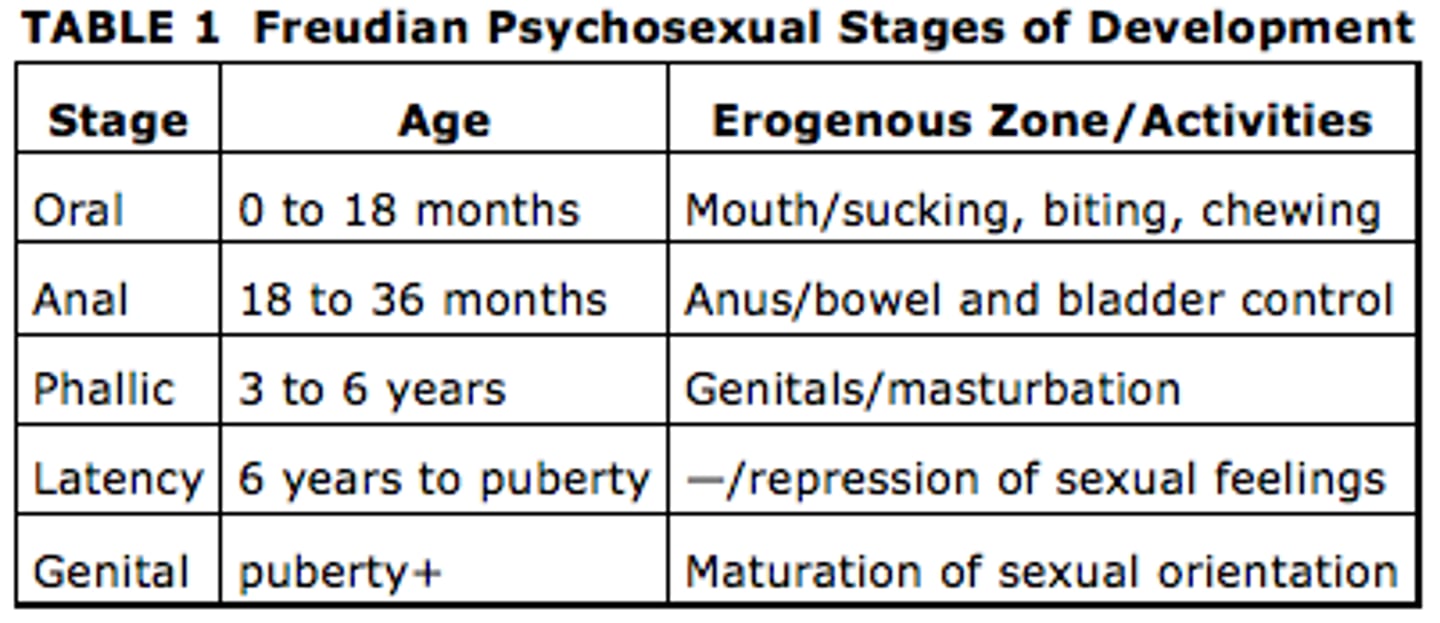
psycho-social theory
Erikson emphasized that in addition to mediating between id impulses and superego demands, the ego makes a positive contribution to development, acquiring attitudes and skills that make the individual and active, contributing member of society
Erikson
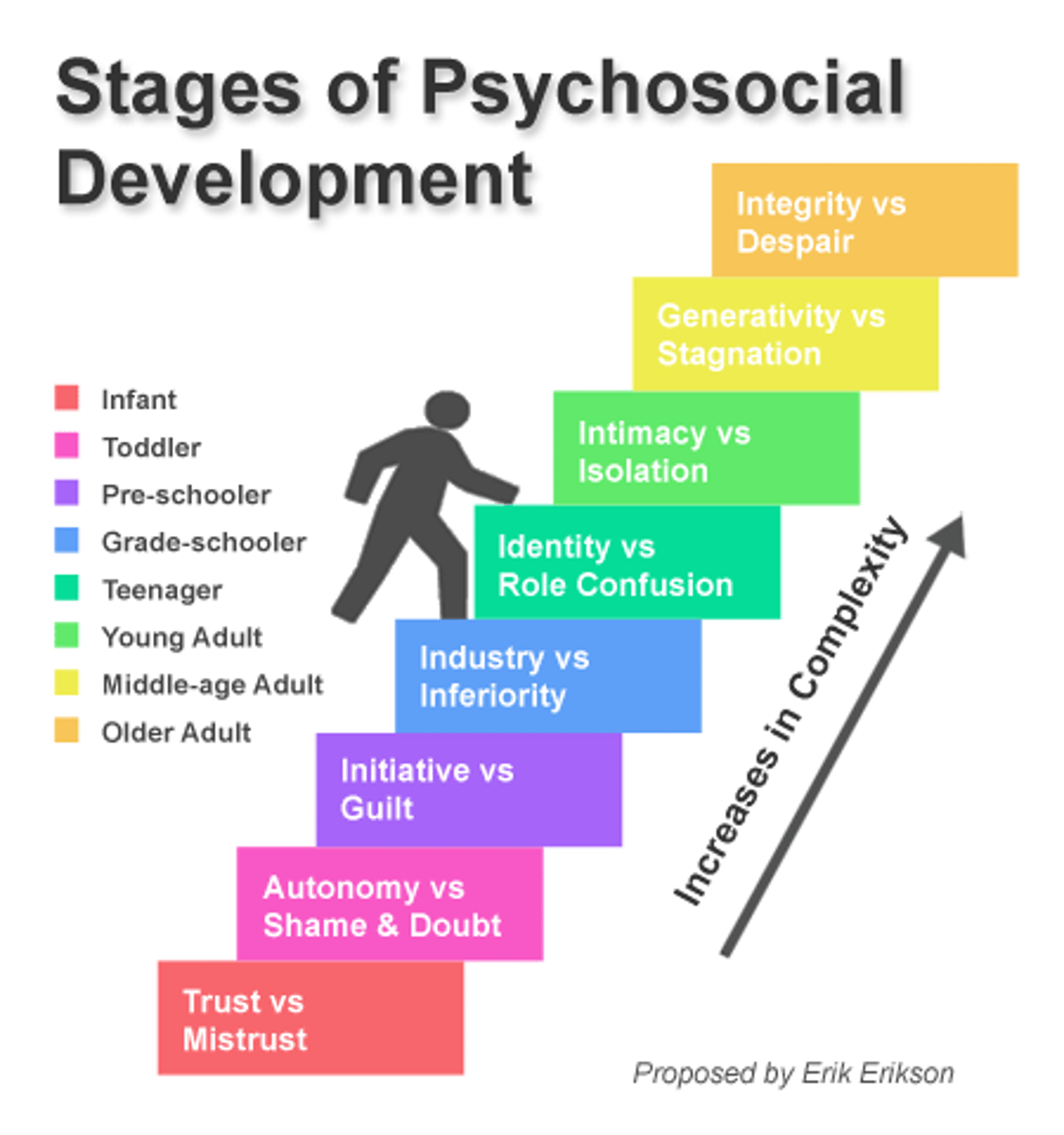
behaviorism
directly observable events- stimuli and responses- are the appropriate focus of study
Classical conditioning
Conditioned stimulus --> Conditioned response
-connecting 2 separate stimuli
-Pavlov & Watson
Operant conditioning
-BF Skinner
-Reinforcers and
punishments
Social learning
theory: Albert Bandera
Social-cognitive
approach: If you see a social agent performing an action, a developing agent will do it too to gather information about the world
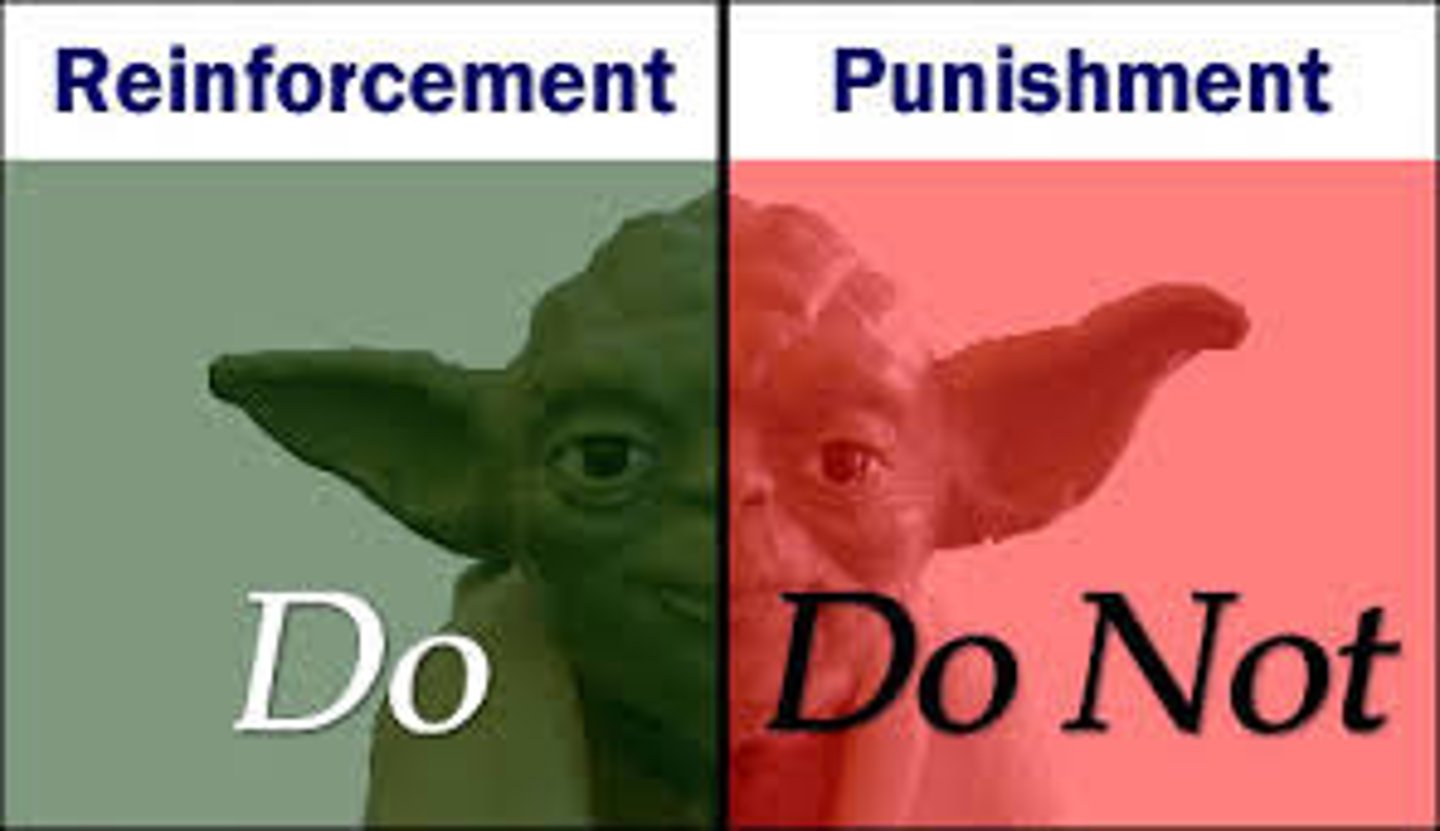
dependent variable
The measurable effect, outcome, or response in which the research is interested.
Effect
What you are measuring
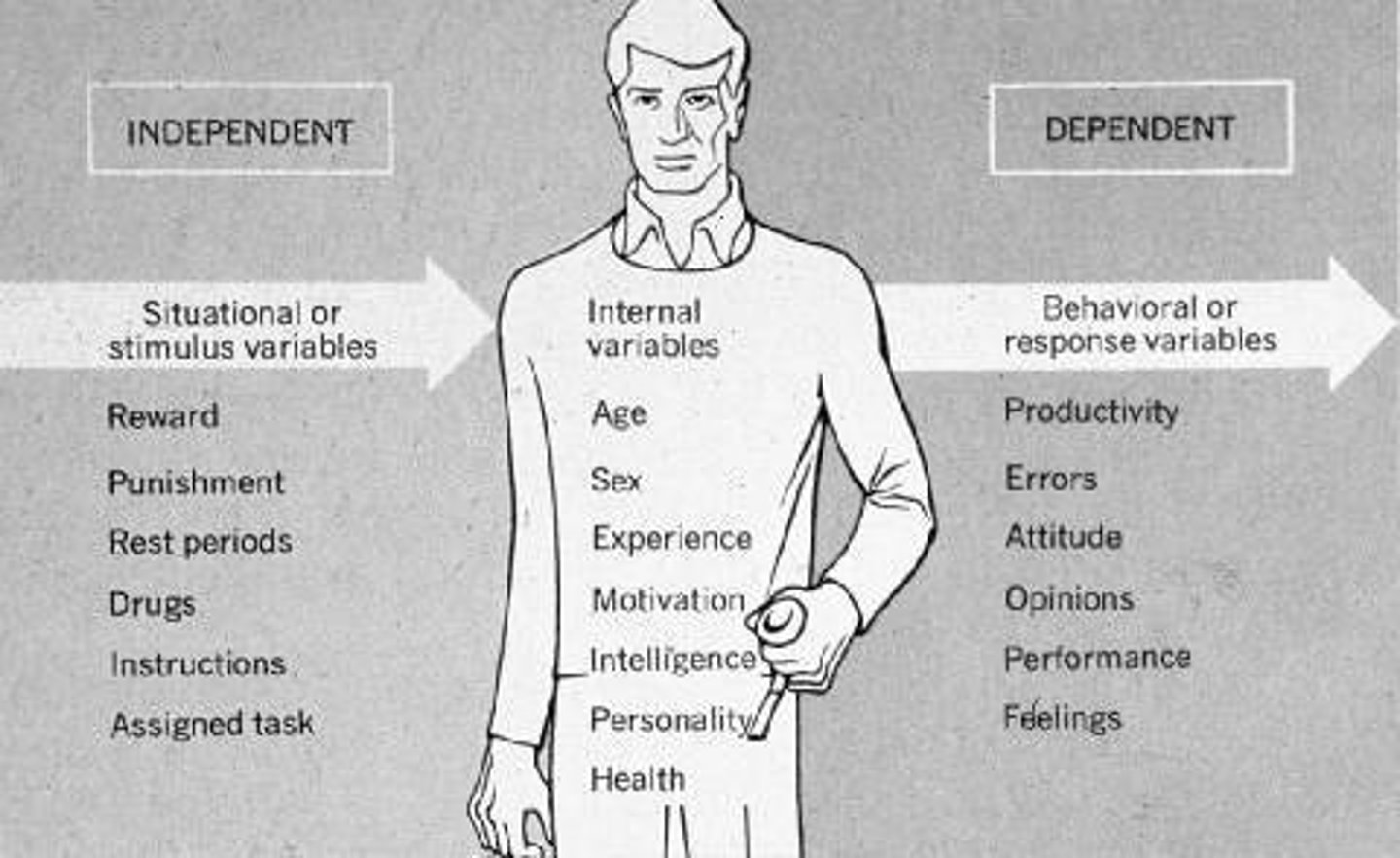
independent variable
The varible you change to see how it will effect the dependent variable
factor that changes in an experiment
A researcher wants to know whether noise level affects workers blood pressure. In one group, she varies the levels of noise in the environment and records participants blood pressure. In this experiment, the level of noise is the
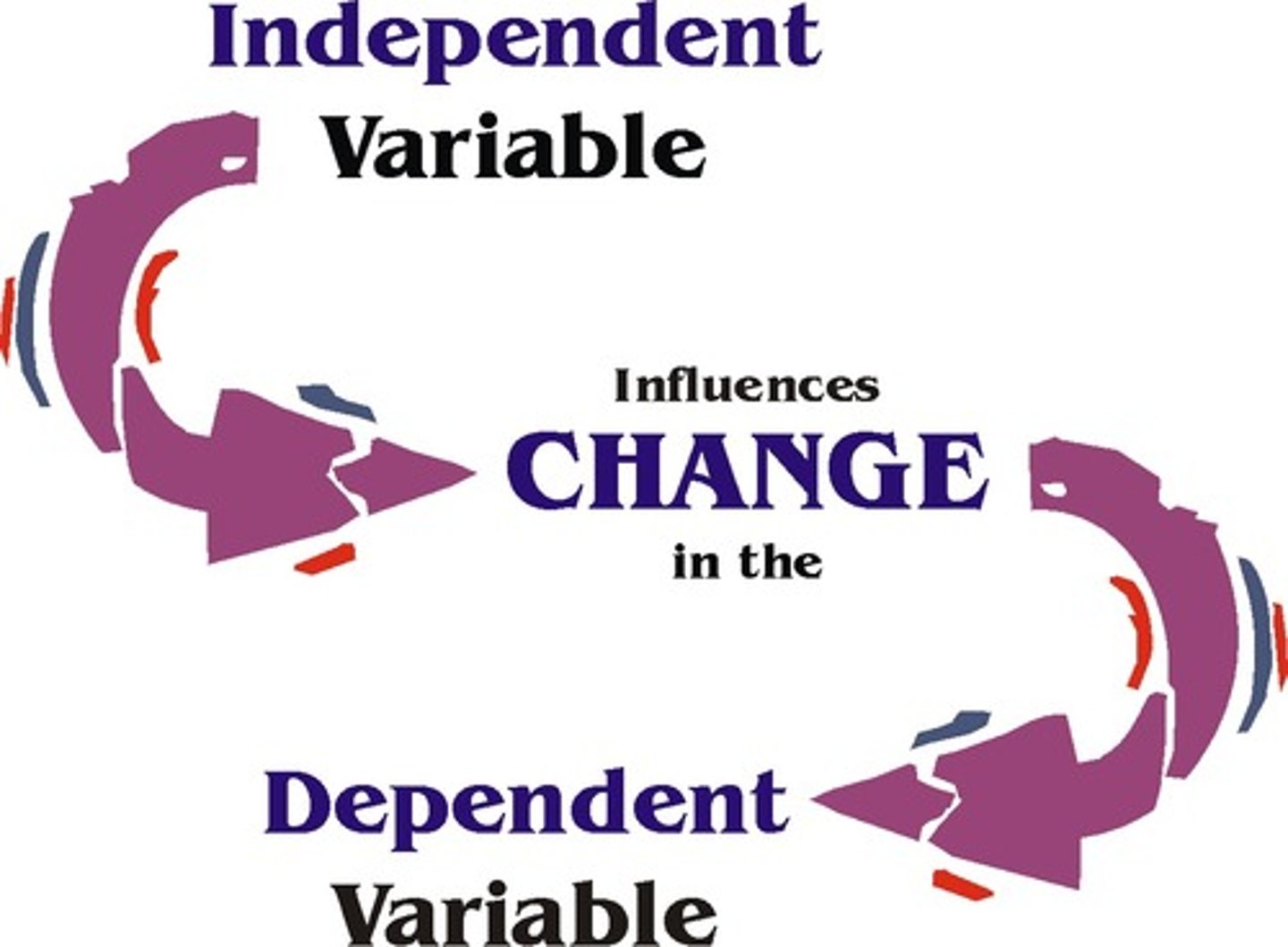
social learning theory
devised by Albert Bandura, emphasizes modeling, also known as imitation or observational learning as a powerful source of development
Contributions:
behavior modification
modeling, observational learning
Limitations:
narrow view of environmental influences and
underestimates individual's active role
Albert Bandura
1925-present; Field: sociocultural; Contributions: pioneer in social learning theory and observational learning,
stated that people profit from the mistakes/successes of others; Studies: Bobo Dolls-adults demonstrated 'appropriate' play with dolls, children mimicked play
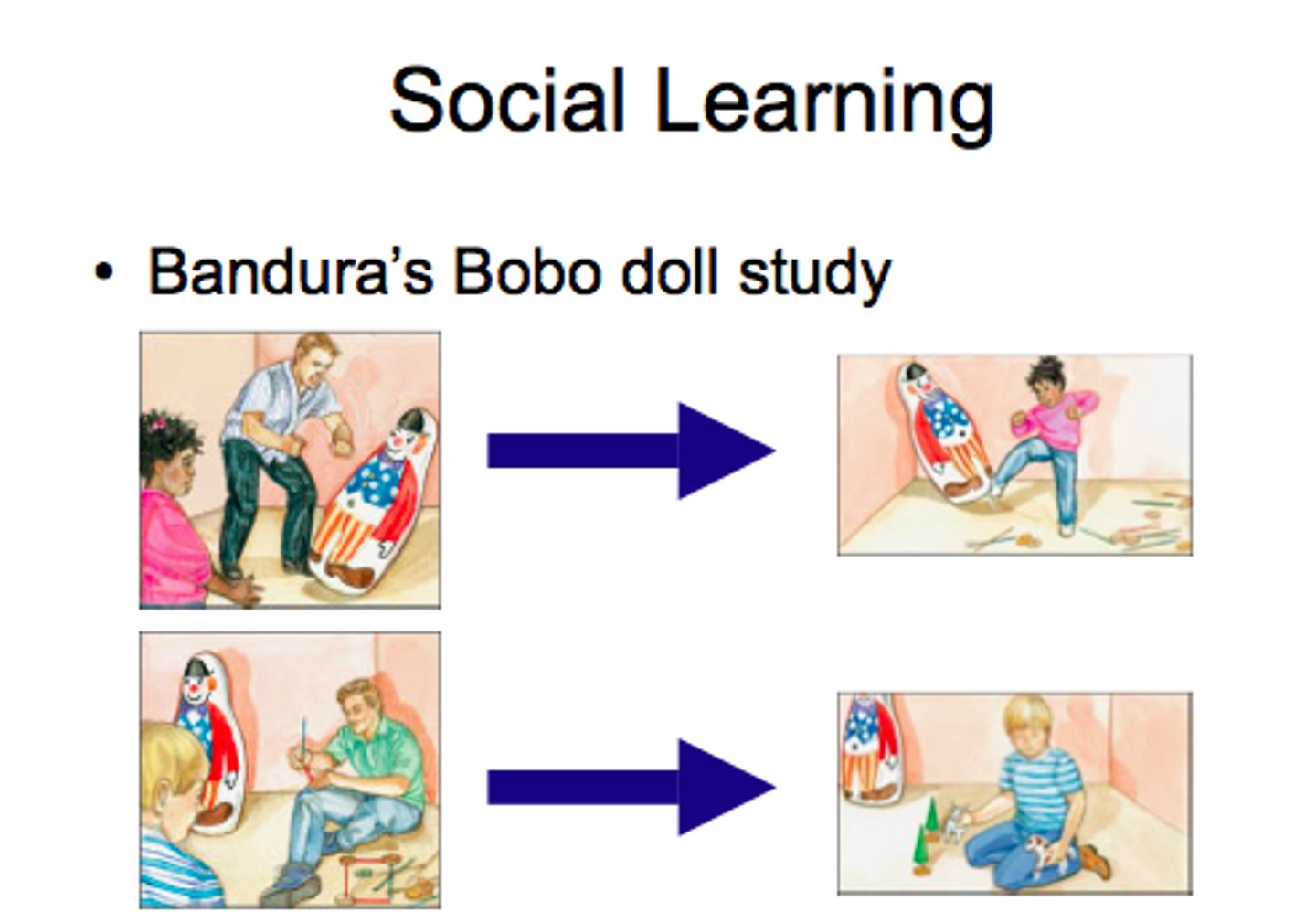
behavior modification
consists of procedures that combine conditioning and modeling to eliminate undesirable behaviors and increase desirable responses
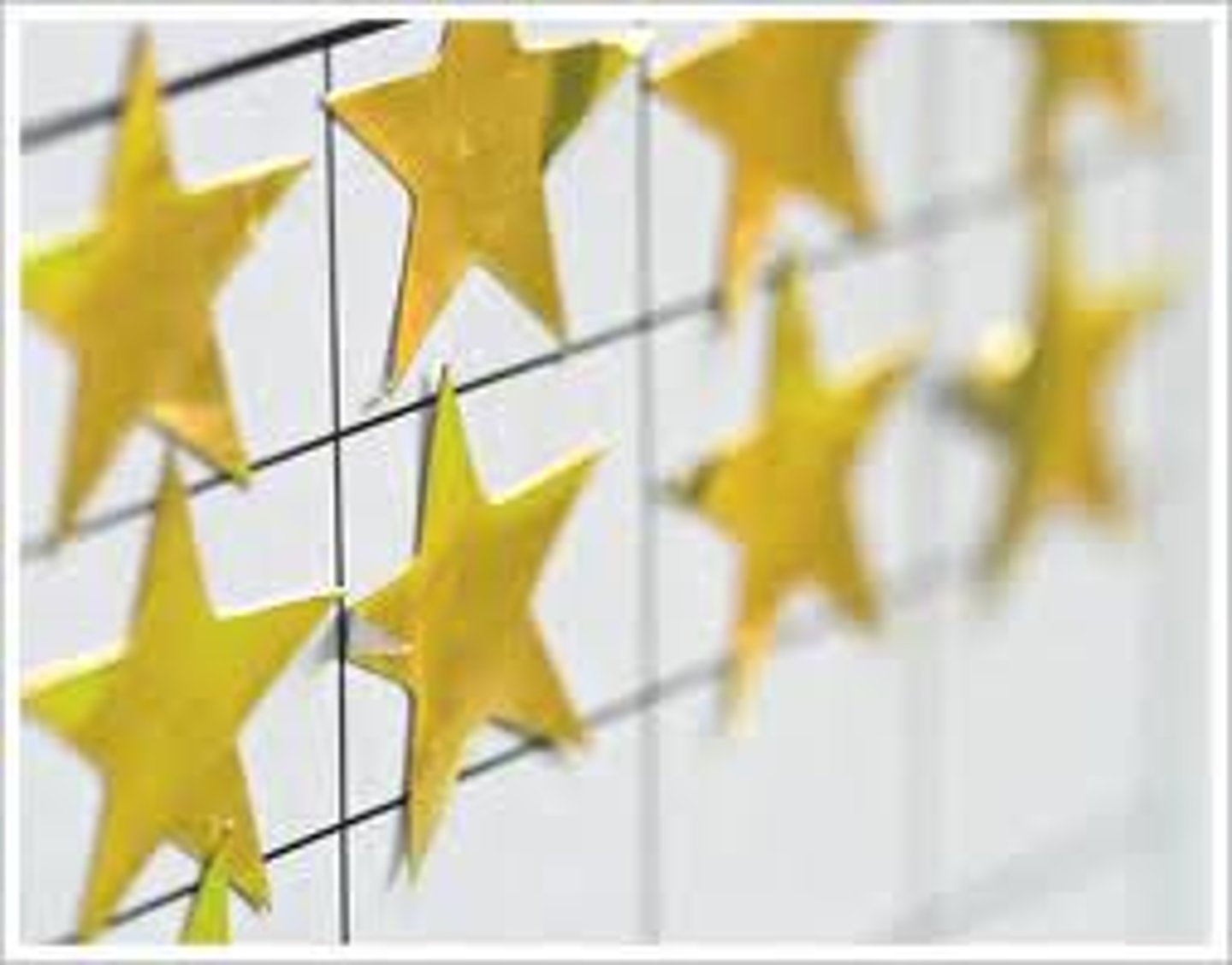
cognitive-developmental theory
children actively construct knowledge as they manipulate and explore their world
Mental structures adapt to better fit with
environment.
Development moves through four broad
stages.
Piaget
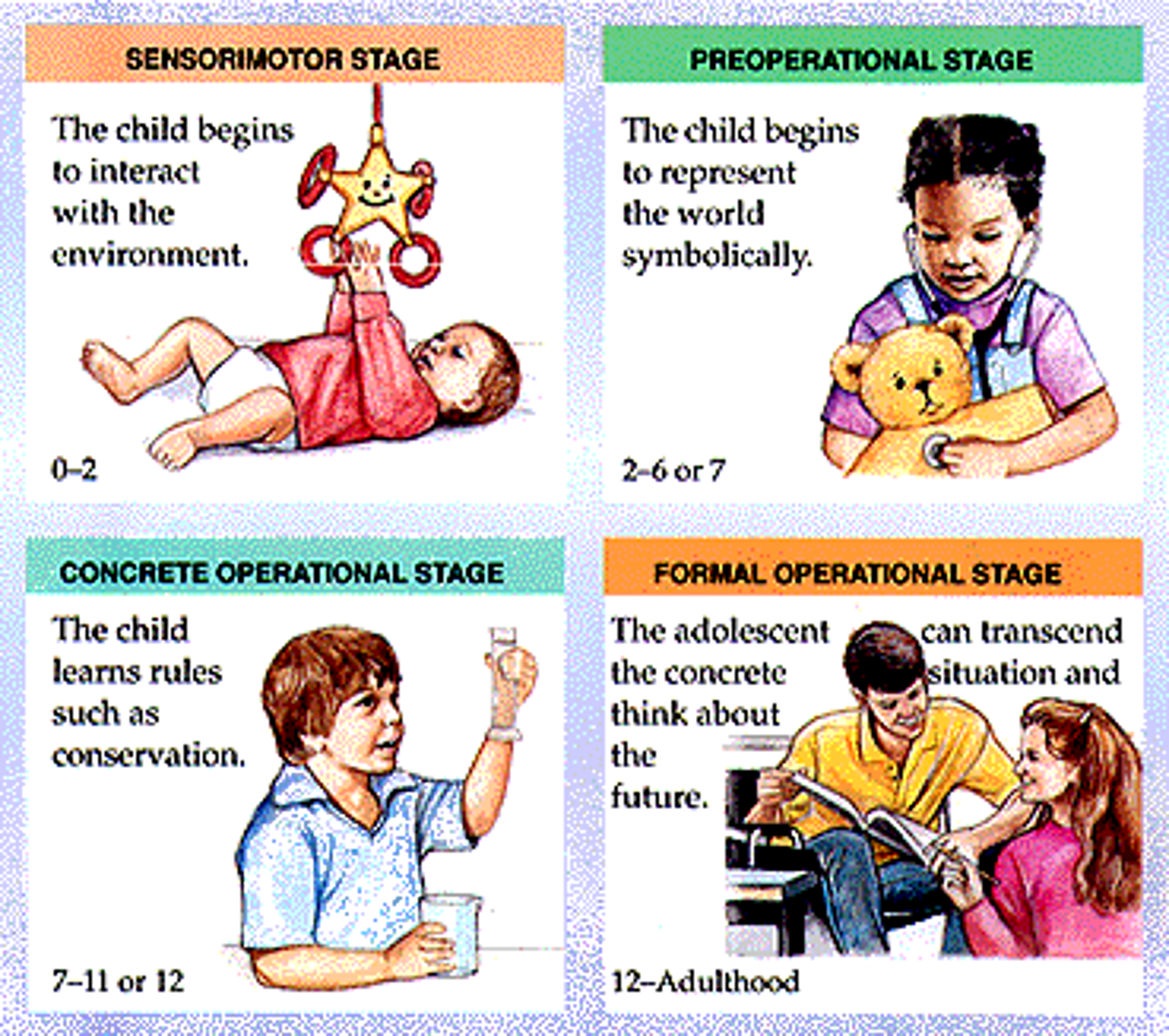
Piaget's stages of cognitive development
sensorimotor (birth to 2yrs): experiencing the world through senses and actions(looking, hearing, touching, mouthing, grasping)
preoperational (2-6yrs): representing things with words and images; using initiative rather than logical reasoning.
Concrete operational (7-11yrs): thinking logically about concrete events; grasping concrete analogies and performing arithmetical operations.
Formal operational (12-adult years): abstract reasoning.
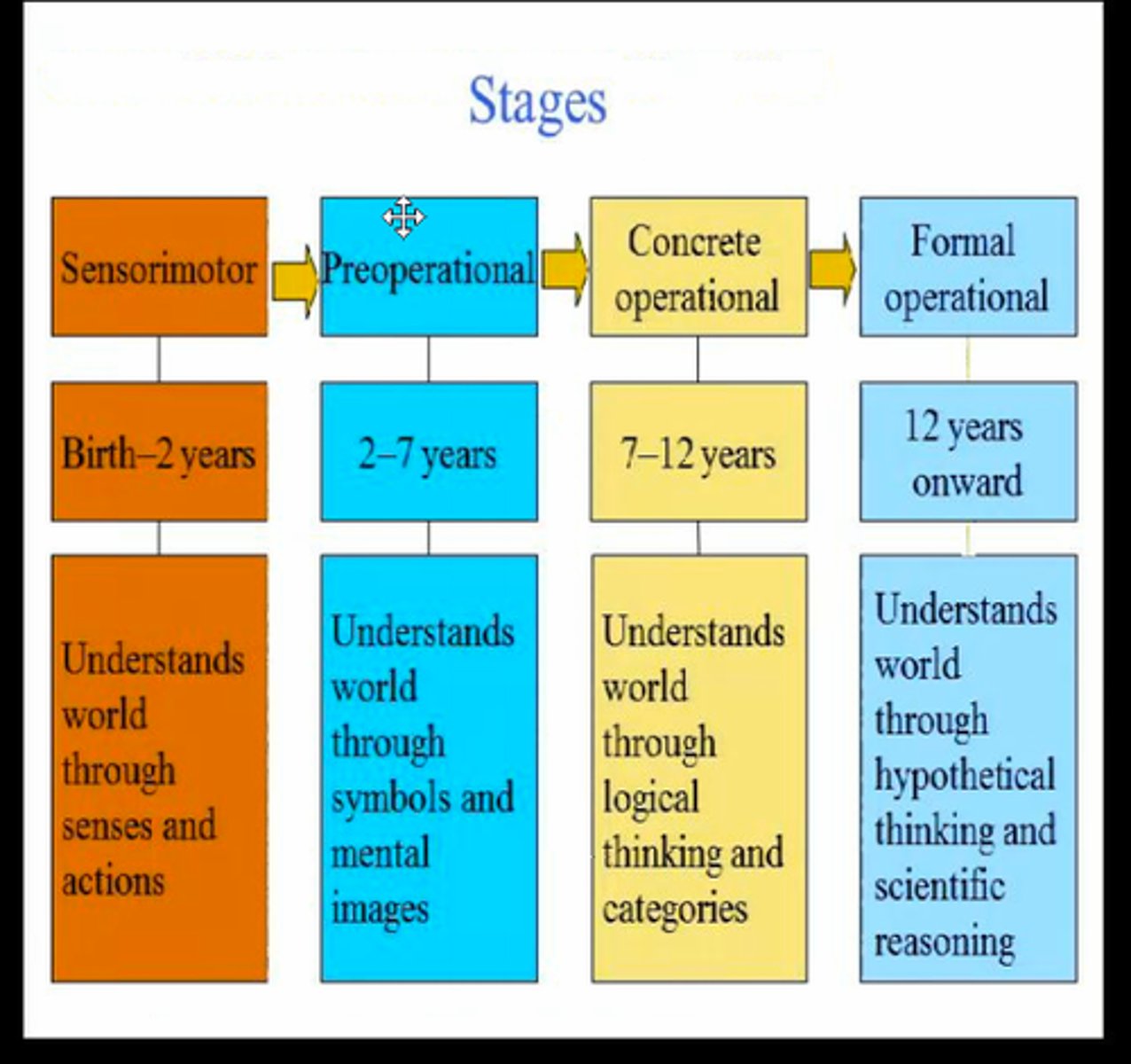
Piaget's Stages of Cognitive Development: formal operational (12-adult years)
The capacity for abstract, systematic thinking enables adolescents, when faced with a problem, to start with a hypothesis, deduce testable inferences, and isolate and combine variables to see which inferences are confirmed. Adolescents can also evaluate the logic of verbal statements without referring to real-world circumstances.
Piaget's Stages of Cognitive Development: concrete operational (7-11yrs)
Children's reasoning becomes logical and better organized. School-age children understand that a certain amount of lemonade or play dough remains the same even after its appearance changes. They also organize objects into hierarchies of classes and subclasses. However, children think in a logical, organized fashion only when dealing with concrete information they can perceive directly.
Piaget's Stages is Cognitive Development: preoperational (2-6yrs)
representing things with words and images; using initiative rather than logical reasoning. Preschool children use symbols to represent their earlier sensorimotor discoveries. Development of language and make-believe play takes place. However, thinking lacks the logic of the two remaining stages.
Piaget's Stage of Cognitive Development: sensorimotor (birth to 2yrs)
experiencing the world through senses and actions(looking, hearing, touching, mouthing, grasping). Infants think by acting on the world with their eyes, ears, hands, and mouth. As a result, they invent ways of solving sensorimotor problems, like pulling a lever to hear a sound, finding hidden toys, and putting objects into and taking them out of containers.
information processing
that the human mind might also be viewed as a symbol, manipulating system through which information flows
Development as a continuous
process
Use of rigorous research methods
Little insight into creativity or
imagination
developmental cognitive neuroscience
brings together researchers from psychology, biology, neuroscience, and medicine to study the relationship between changes in the brain and the developing person's cognitive processing and behavior patterns
Practical applications
developmental social neuroscience
devoted to studying the relationship between changes in the brain and emotional and social development
ethology
adaptive, or survival, value of behavior and it's evolutionary history
Stresses that behavior is strongly influenced by biology, is tied to evolution, and is characterized by critical or sensitive periods.
critical period
The time in to development of an organism when it is especially sensitive to certain environmental influences; outside of that period the same influences will have far less effect
sensitive period
a time that it is optimal for certain capacities to emerge and in which the individual is especially responsive to environmental influences. however. its boundaries are less well-defined than those of a critical period. development can occur later, but it is harder to induce
imprinting
A type of learning that is responsible for the bonding between the mother and offspring; common in birds, it occurs during a sensitive or critical period in early life
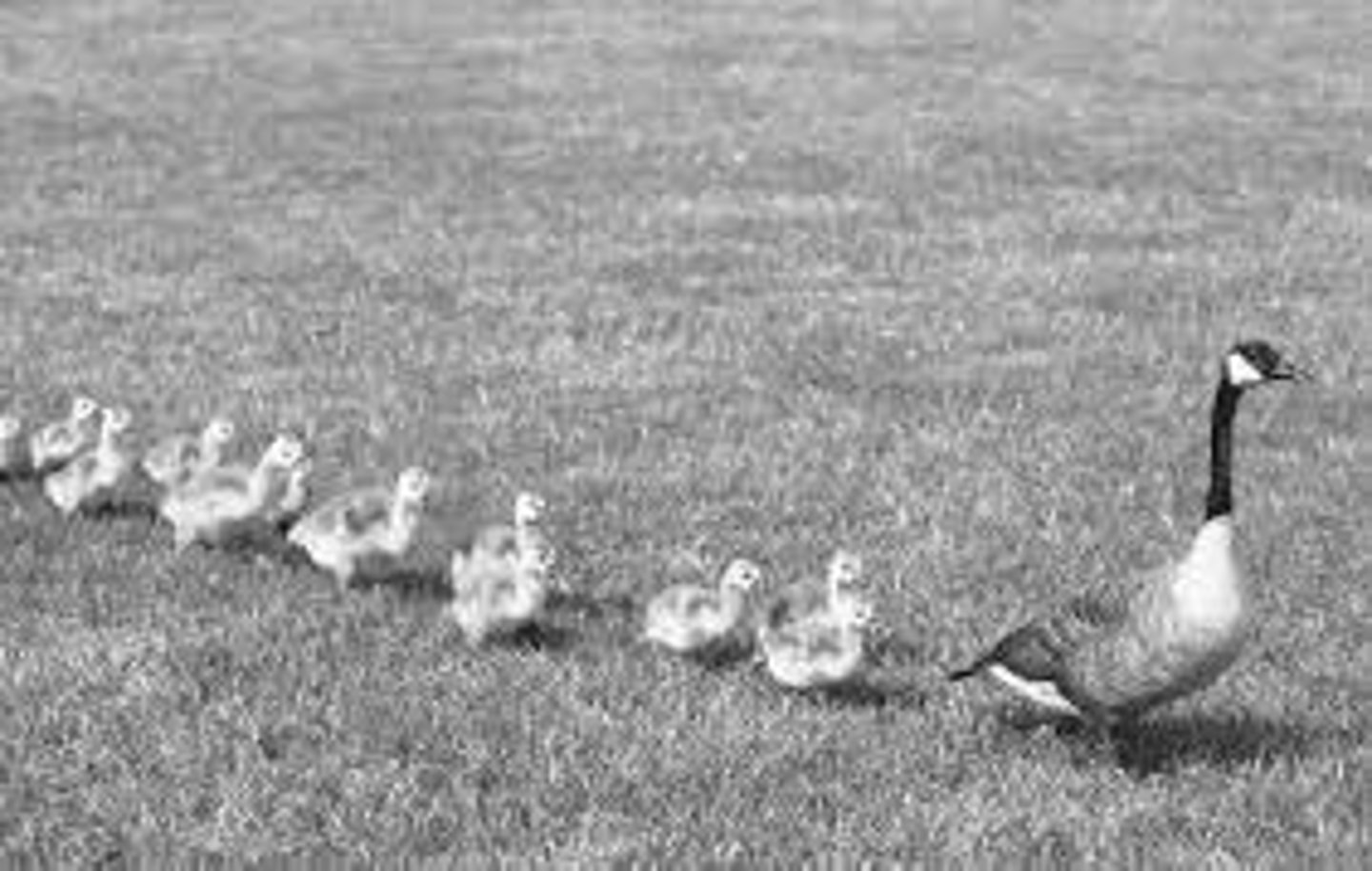
evolutionary developmental psychology
it seeks to understand the adaptive value of species-wide cognitive, emotional, and social competencies, as those competencies change with age
Person-environment system throughout
the lifespan
socio-cultural theory
focuses on how culture- the values, beliefs, customs, and skills of a social group- is transmitted to the next generation. according to Vygotsky, social interaction- in particular,
cooperative dialogues with more knowledgeable members of society- is necessary for children to acquire the ways of thinking and behaving that make up a community's culture

Lev Vygotsky
Placed particular emphasis on how culture and social interactions with parents and other significant people influenced a child's cognitive development. Children learn their culture's habits of mind through internalization.
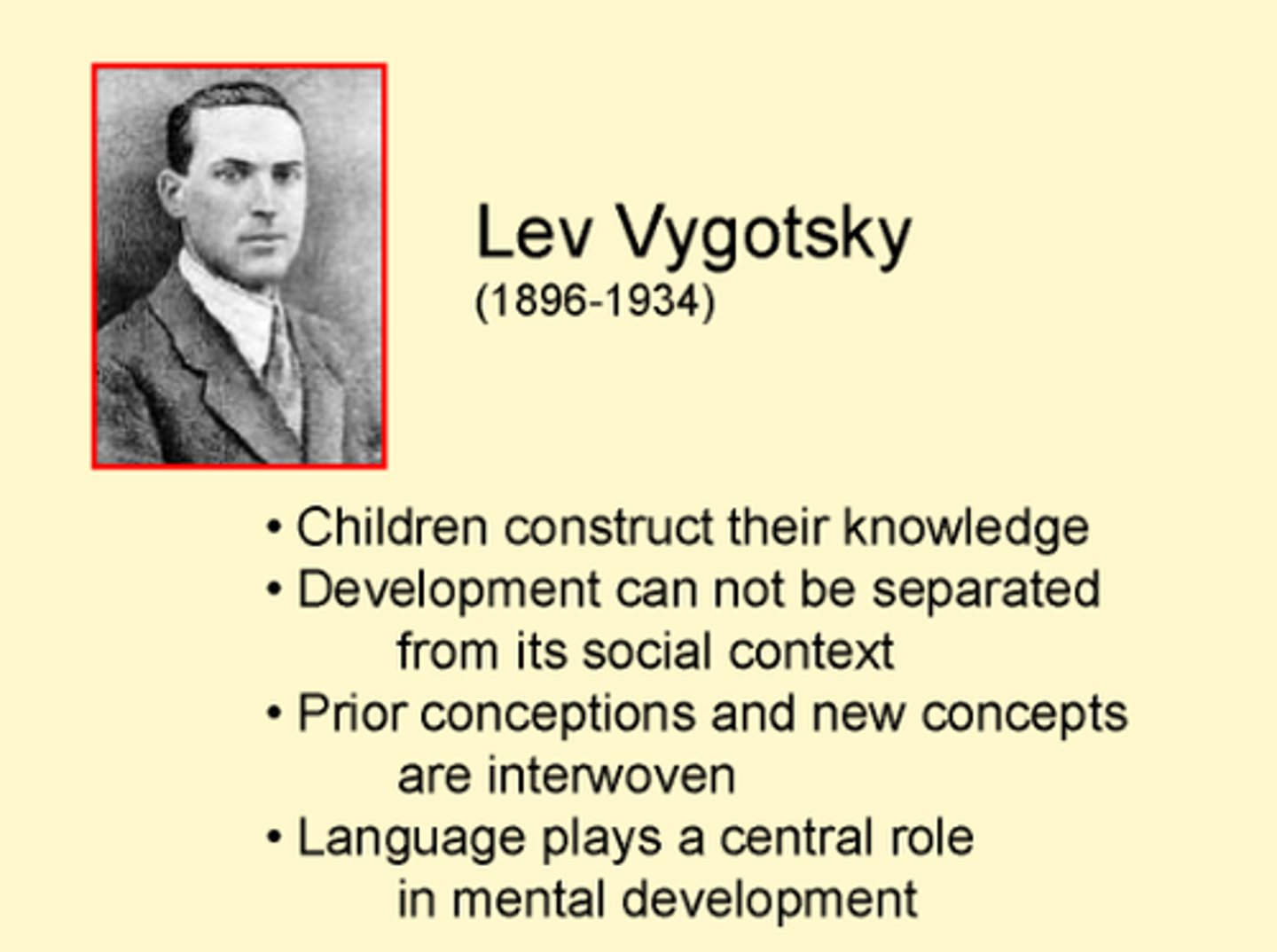
ecological systems theory
views the person as developing within a complex system of relationships affected by multiple levels of the surrounding environment
Layers of the
environment:
microsystem
mesosystem
exosystem
macrosystem
Chronosystem:
temporal dimension

the microsystem
the innermost level of the environment which consists of activities and interaction patterns in the person's immediate surroundings
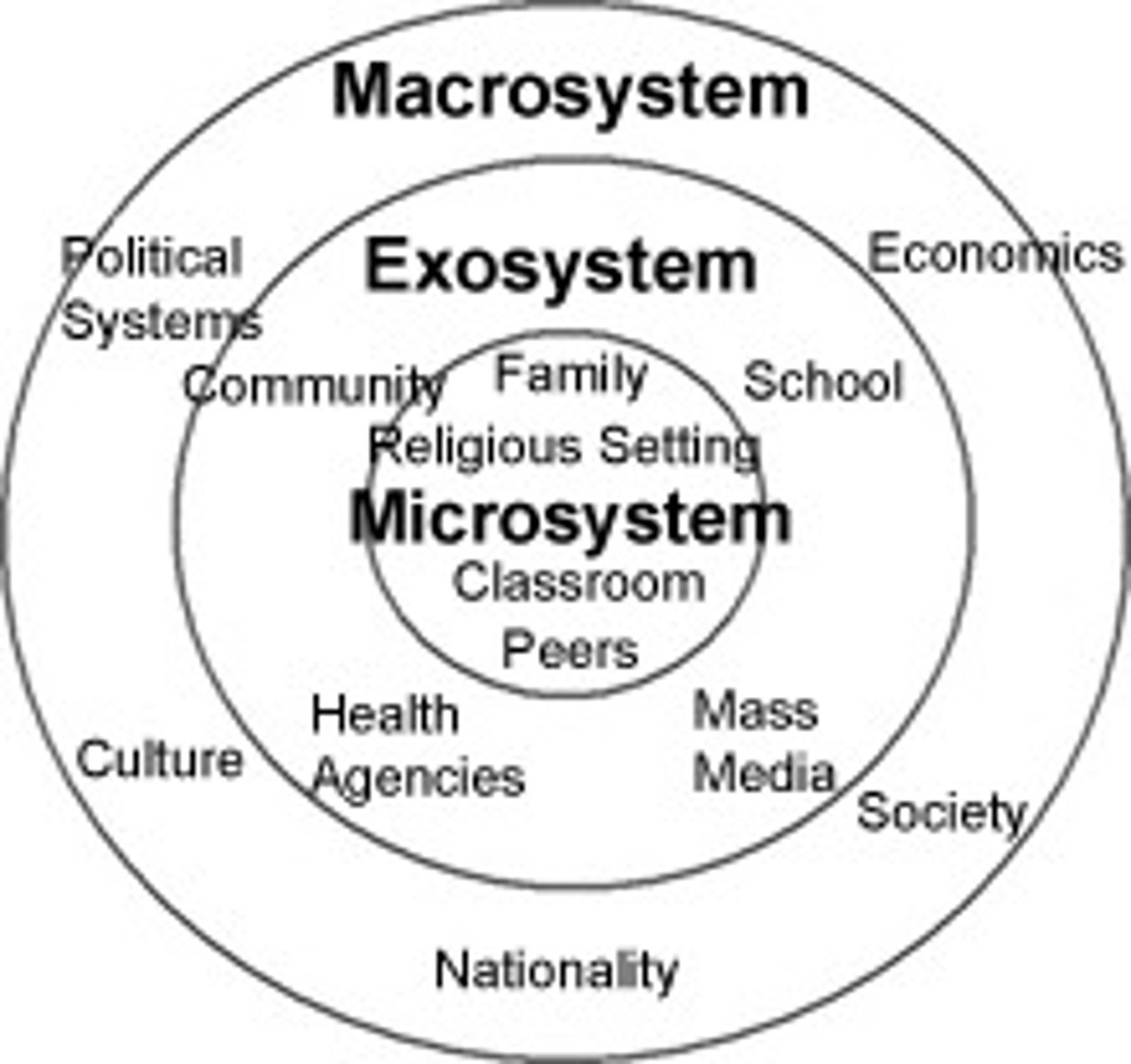
the mesosystem
the second level of Brofenbrenner's model which encompasses connections between microsystems
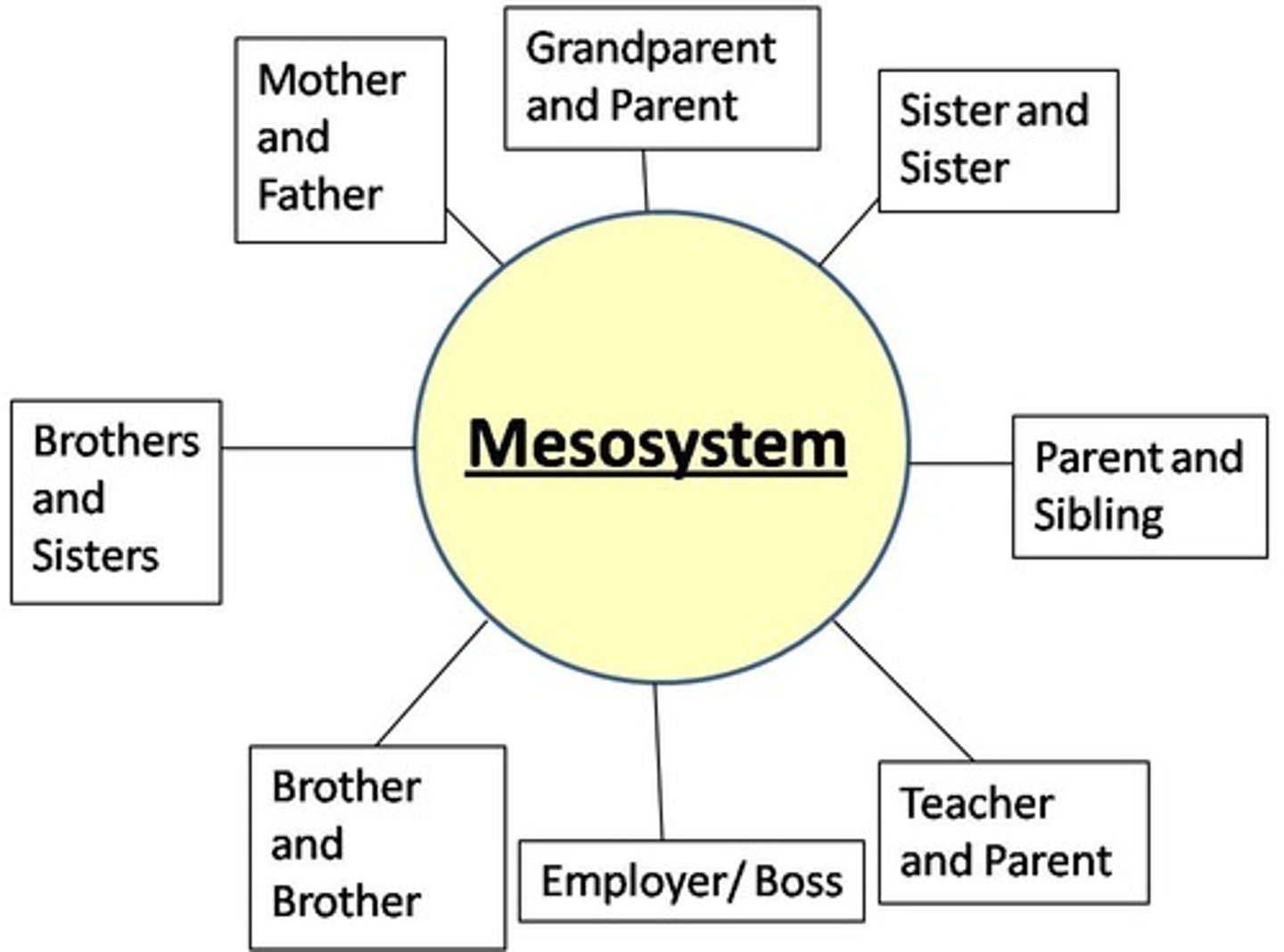
the exosystem
consists of social settings that do not contain the developing person but nevertheless affect experiences in immediate settings
the macrosystem
consists of cultural values, laws, customs, and resources
the chronosystem
the temporal dimension of TIME of Brofenbrenner's model on which life changes can be imposed externally, or alternatively, can arise from within the person, since individuals select, modify, and create many of their own settings and experiences
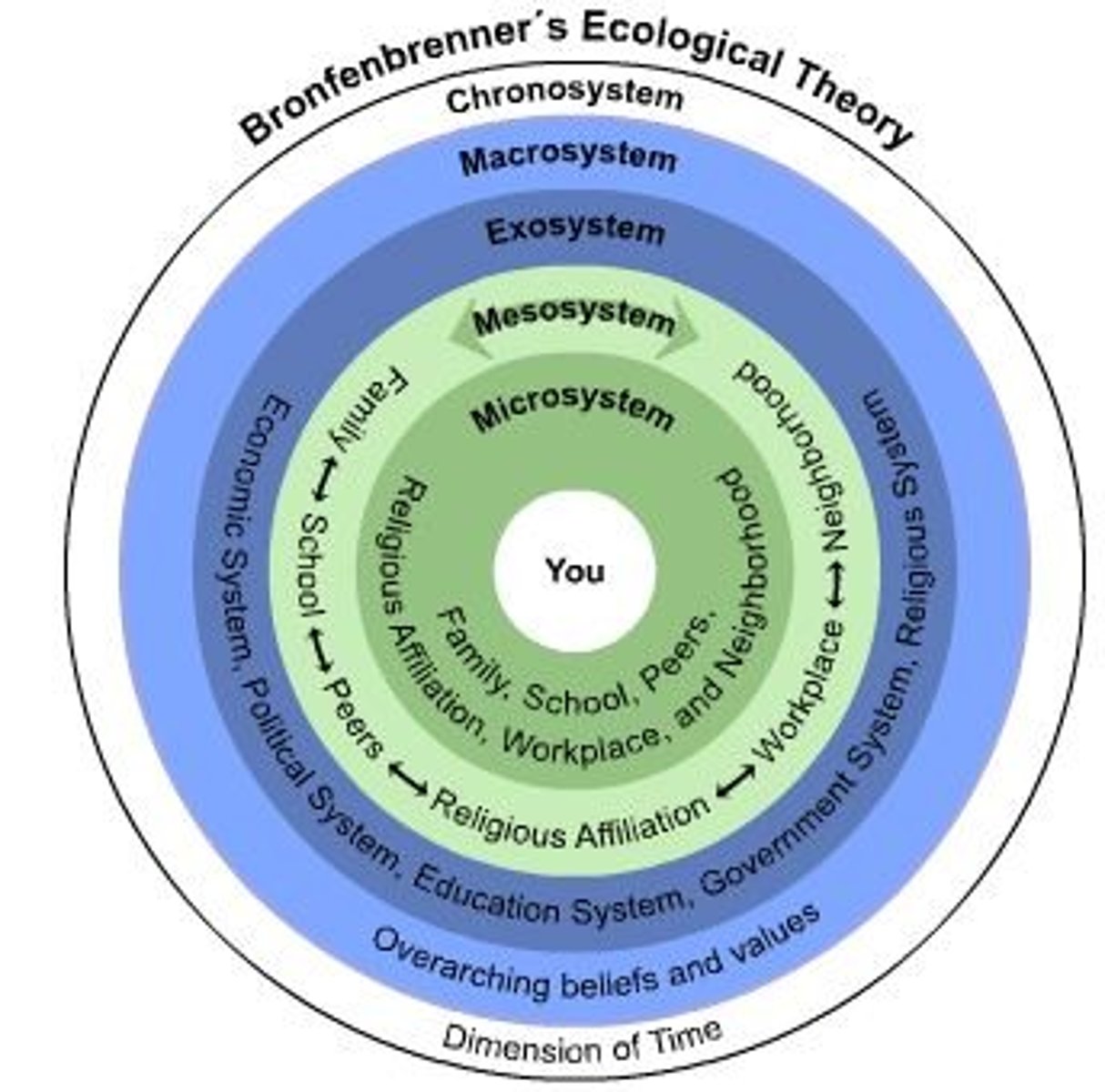
research methods
Systematic observation
-Naturalistic observation
-Structured observation
Self-reports:
-Clinical interview
-Structured interview, questionnaires,
tests
Clinical, or case study, method
Ethnography
systemic observation
Naturalistic
Observation
-Observation of behavior in natural contexts
-Reflects participants' everyday lives
Structured Observation
-Observation of behavior in laboratory
-Gives all participants opportunity to display behavior
naturalistic observation
Type of systematic observation that goes into the field, or natural environment, and record the behavior of interest. May not see desired action even after waiting long periods. Strengths: reflects participants' everyday lives. Limitations: can not control conditions under which participants are observed.

structured observation
Type of systemic observation in which the investigator sets up a laboratory situations that evokes the behavior of interest so that every participant has equal opportunity to display the response. Can set up stimulus to get desired response. Strengths: grants each participant an equal opportunity to display the behavior of interest. Limitations: may not yield observations typical of participants' behavior in everyday life.
Ethnography
descriptive, qualitative research which is directed toward understanding a culture or distinct social group through participant observation
Strengths: provides rich, descriptive insights into factors that affect development. Limitations: Does not permit generalization from
findings. May be biased by researchers values and theoretical influences.
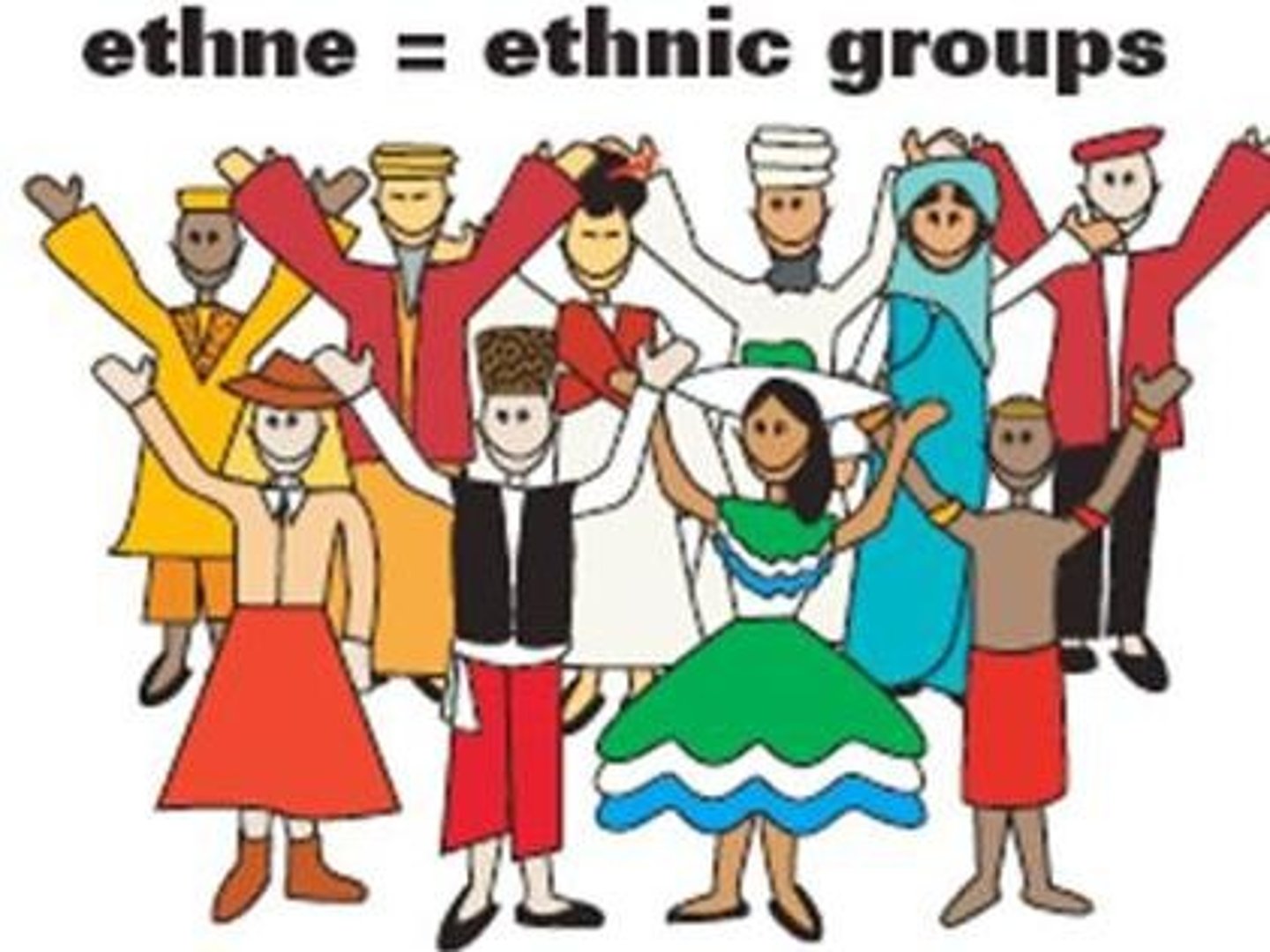
cohort effects
individuals born in the same time period are influenced by a particular set of historical and cultural conditions. results based on one cohort may not apply to people developing at other times
Freud's Psychosexual Stage: birth - 1 year
Oral: if oral needs are not met through sucking from breast or bottle, individual may develop habits like thumb sucking, fingernail biting, overeating, or smoking.
Frued's Psychosexual Stage: 1-3 years
Anal: toddlers and preschoolers enjoy holding and releasing urine and feces. If parents toilet train before children are ready or make too few demands, conflicts about anal control may appear in the form of extreme orderliness or disorder.
Frued's Psychosexual Stage: 3-6 years
Phallic: as preschoolers take pleasure in genital stimulation, Frued's Oedipus complex for boys and Electra complex for girls arise: children feel a sexual desire for other sex parent, to avoid punishment, they give up this desire and adopt the same sex parent's characteristics and values. As a result, the superego is formed and children feel guilty when they violate its standards.
Frued's Psychosexual Stage: 6-11 years
Latency: sexual instincts die down, and the superego strengthens as children acquire new social values from adults and peers.
Frued's Psychosexual Stage: adolescence
Genital: with puberty, sexual impulses reappear. Successful development during earlier stages leads to marriage, mature sexuality and child rearing.
Erikson's Psychosocial Stage: birth - 1 year
Basic trust vs mistrust: from warm, responsive care, infants gain a sense of trust, or confidence, that the world is good. Mistrust occurs if infants are neglected or handled harshly.
Erikson's Psychosocial Stage: 1-3 years
Autonomy vs shame and doubt: using new mental and motor skills, children want to decide for themselves. Parents can foster autonomy by permitting reasonable free choice and not forcing or shaming the child.
Erikson's Psychosocial Stage: 3-6 years
Initiative vs guilt: through make-believe play, children gain insight into the person they can become. Initiative (a sense of ambition and responsibility) develops when parents support their child's sense of purpose. If parented demand too much self-control children experience excessive guilt.
Erikson's Psychosocial Stage: 6-11 years
Industry vs inferiority: at school, children learn to work and cooperate with others. Inferiority develops when negative experiences at home, at school, or with peers lead to feelings of incompetence.
Erikson's Psychosocial Stage: adolescence
identity vs role confusion: by exploring values and vocational goals, young people form a personal identity. The negative outcome is confusion about future adult roles.
Erikson's Psychosocial Stage: early adulthood
Intimacy vs isolation: young adults establish intimate relationships. Because of earlier disappointments, some individuals cannot form close bonds and remain isolated.
Erikson's Psychosocial Stage: middle adulthood
Generativity vs stagnation: generativity means giving to the next generation through child rearing, caring for others, or productive work. The person who fails in these ways feels an absence of meaningful accomplishment.
Erikson's Psychosocial Stage: old age
Integrity vs despair: integrity results from feeling that life was worth living as it happened. Older people who are dissatisfied with their lives fear death.
Stance on Psychoanalytic perspective:
Discontinuous: psychosexual and psychosocial Development takes place in stages. One course of development: stages are assumed to be universal. Both nature and nurture: innate impulses are channeled and controlled through child-rearing experiences. Early experiences set the course of later development.
Stance on Behaviorism and Social Learning Theory
Continuous: development involves an increase in learned behaviors. Many possible courses of development: behaviors reinforced and modeled may vary from person to person. Emphasis on nurture: development is the result of conditioning and modeling. Both early and later experiences are important.
Stance on Piaget's Cognitive Developmental Theory
Discontinuous: Cognitive development takes place in stages. One course of development: stages are assumed to be universal. Both nature and nurture: development occurs as the brain grows and children exercise their innate drive to discover reality in a generally stimulating environment. Both early and later experiences are important.
Stance on Information Processing Theory
Continuous: children and adults change gradually in perception, attention, memory, and problem solving skills. One course of development: changes studies characterize most or all children and adults. Both nature and nurture: children and adults are active, sense-making beings who modify their thinking as the brain grows and they confront new environmental demands. Both early and later experiences are important.
Stance on Ethology and Evolutionary Developmental Theory
Both continuous and discontinuous: children and adults gradually develop a wider range of adaptive behaviors. Sensitive periods occur in which qualitatively distinct capacities emerge fairly suddenly. One course of development: adaptive behaviors and sensitive periods apply to all members of a species. Both nature and nurture: evolution and heredity influence behavior, and learning lends greater flexibility and adaptiveness to it. In sensitive periods, early experiences set the course of later development.
Stance on Vygotsky's Sociocultural Theory
Both continuous and discontinuous: language acquisition and schooling lead to stagewise changes. Dialogues with more expert members of society also result in continuous changes that vary from culture to culture. Many possible courses of development: socially mediated changes in thought and behavior vary from culture to culture. Both nature and nurture: heredity, brain growth, and dialogues with more expert members of society jointly contribute to development. Both early and later experiences are important.
Stance on Ecological Systems Theory
Not specified whether continuous or discontinuous. Many possible courses of development: biologically influenced dispositions join with environmental forces at multiple levels to mold development in unique ways. Both nature and nurture: the individual's characteristics and the reactions of others affect each other in a bidirectional fashion. Both early and later experiences are important.
Stance on Lifespan Perspective Theory
Both continuous and discontinuous: continuous gains and declines and discontinuous, stagewise emergence of new skills occur. Many possible courses of development: influenced by multiple, interacting biological, psychological, and social forces, many of which vary from person to person, leading to diverse pathways of change. Both nature and nurture: development is multidimensional, affected by an intricate blend of hereditary and environmental factors. Emphasizes plasticity at all ages. Both early and later experiences are important.
What is developmental science, and what factors stimulated expansion of the field?
Developmental science is a field devoted to understanding human constancy and change throughout the lifespan. Research on human development ya been stimulated by both scientific curiosity and social pressures to improve people's lives.